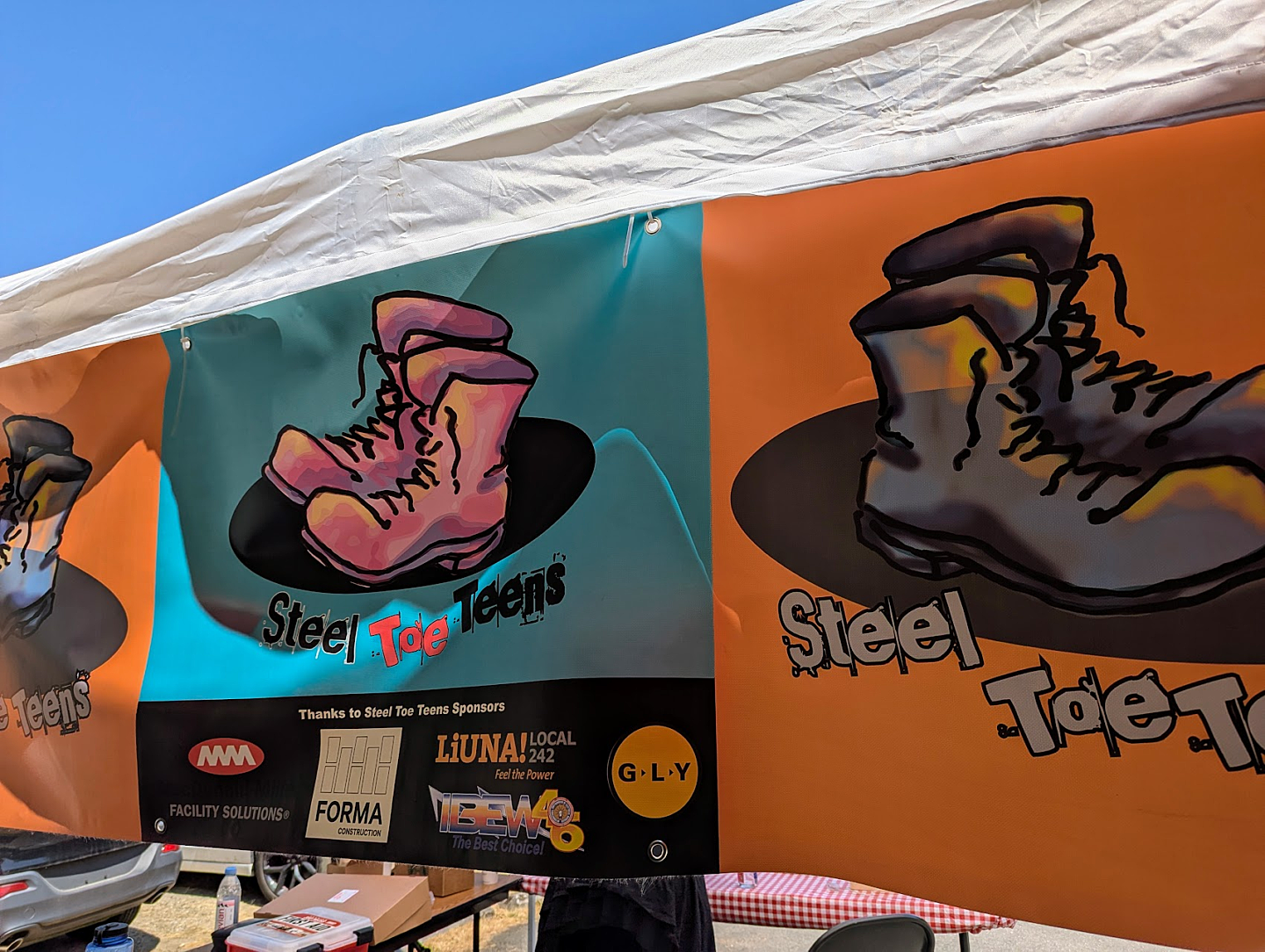DEIB

Insights 08.20.2025
Steel Toe Teens Camp—Why Early Exposures Matter
From power tools to possibility—Elie Egan reflects on volunteering at a camp that introduces girls to the trades.

Elie Egan
General Forewoman

National Hispanic Heritage Month [September 15 – October 15] recognizes the achievements and contributions of inspiring Hispanic American champions. To celebrate, we asked a few of our own employees to share stories of their upbringings and provide a glimpse into Hispanic culture. Shared internally over the last thirty days, we now invite YOU to get to know these amazing, inspiring Hispanic American individuals.

Jose Ramos, Assistant Superintendent
I was born in Puerto Rico, a United States territory, and lived there for almost half my childhood. At the time, I took for granted how my father and I would catch crab and lobster to eat fresh for dinner on a regular basis. I was always full of vinegar—still am, as many of you know.
We moved to New York for a short period of time when I was in elementary school. We lived in a Puerto Rican neighborhood with a bodega in walking distance. In our family, everyone you meet is family, so it didn’t take long before I considered the majority of people I met to be cousins even though we were not related. My mom always cooked big meals with large pots of rice and beans to share with the neighbors. Food brought us together—still does!
I tested my parents’ patience every so often. If I saw a consequence on the horizon, I would run into our fruit-tree-filled backyard and find a hiding spot out of reach of my mom’s Chancla [a flip flop or sandal used as a form of discipline]. Any Spanish kid knows a mom and her Chancla is no joke! I would sit high up in a tree for hours, eat the fruit, and wait for my parents to soften. Let’s just say I got my fill of bananas, pomegranates, mangos, and quenepas.
Now living in Seattle, far from Puerto Rico, my wife and I try to incorporate Spanish heritage into our daughters’ daily lives as much as possible. We cook many traditional Puerto Rican meals—one of their favorites is a tomato broth soup with handmade noodles—and every summer, we have quenepas flown in. These little fruits are a cousin to lychee, but green and oh so sweet.
Most importantly, I try to teach my girls to work hard and appreciate the luxuries around them. Growing up, my home in Puerto Rico sat on a hillside overlooking the ocean. While the surroundings were beautiful, our way of life wasn’t easy. We didn’t have plumbing and instead used an outdoor bathroom, much like a porta-potty. Our water tank sat high in the air to reach the sun, which warmed it up enough to use for showering. We heated the house by manually rolling up the heavy bamboo blinds to let the sun in. The idea of this is so foreign to my kids, as a day without Wi-Fi would be disastrous!
Regardless of what we had/didn’t have as kids, I’m a proud Boricua and love my heritage. The best part of the Puerto Rican culture? The emphasis on “love thy neighbor.” We love to share our culture, homes, and food, and dance, entertain, and spend time with anyone.

Jose’s hometown, San Juan, Puerto Rico.

Quenepas—cousin to lychee, but green and oh so sweet!
I was born in the little town of Valencia, Venezuela. For most of its history, Venezuela was a Spanish colony. It gained independence in 1811 and became a safe haven for immigrants escaping wars. Today, the country enjoys a mix of cultures with a heavy European influence. Here’s a few fun facts about where I come from:
Check out Venezuela today by watching footage from traveling couple, Dos Locos de Viaje.

Visit Canaima National Park in Venezuela to see the world’s tallest, uninterrupted waterfall, Angel Falls.
I am the first generation of my family born in the United States. My parents immigrated to Oceanside, California in their early 20s from a small town called Tamazula, Jalisco, Mexico. After starting a family, they moved to Ellensburg, Washington. People always ask me “Why Ellensburg?” Although there were very few Hispanic people, the average person was kind, accepting of other cultures, and my parents loved it!
Twice a year, I travel to Tamazula, Jalisco to see my grandmother. She owns and operates a cattle and sugar cane farm. My father, brother, and I help her with the more labor-intensive odd jobs while we’re down there. When we aren’t operating machinery or taking down a dead mango tree, we take trips to Manzanillo, Jalisco. This gem of a place beats tourist-heavy Cabo San Lucas with its beautiful beaches and even better food. My brother and I eat as many tacos and locally grown fruits and veggies [coconuts, mangos, avocados, pineapple, etc.] as possible.
When it comes to my favorite holidays, Thanksgiving trumps Dia de los Muertos and Cinco de Mayo. Growing up, we traveled to Phoenix, Arizona to celebrate Thanksgiving with my mother’s side of the family. While it looked similar to most traditional American family Thanksgivings, our turkey was accompanied by tamales, beans, flour tortillas, Mexican rice, enchiladas, flan, and chocolate and guava Atole.

Tamales and atole—two of Isais’s favorite Thanksgiving go-tos!
My fondest memories of my Mexican heritage revolve around Dia de los Muertos [Day of the Dead]. During this two-day celebration [November 1-2], each family sets up an altar to honor their deceased relatives. The goal is to invite them to visit us by providing some of their favorite items as offerings. Each alter is unique, created with love and care, and filled with photos of departed family, food, drinks, and representation of our relatives’ favorite hobbies [a deck of cards, dominos, etc.].
I have vivid memories of this tradition when I was little, and over time, the alters change—naturally gaining more pictures of our relatives. I recommend watching the movie Coco, which provides a great interpretation of this special Mexican Holiday.

Jesus’s festive alter from his family’s 2020 Dia de los Muertos celebration.
I grew up in a small town in upstate New York and was raised by two immigrant parents. My mother, born in El Salvador, met my father, born in Argentina, while going to school in Manhattan in the 1970s [a true melting pot!]. While they were born in Spanish-speaking countries, they both have strong European DNA, as many people fled wars from around the world and emigrated to these areas. Today, I share some of the best parts of these two Hispanic cultures—the food!
Argentina is one of the world’s top—and highest quality—beef exporters. In the 1500s, Spanish Conquistadores brought cattle to Argentina, where they thrived because of the expansive land and ability to roam. Due to the availability of beef, it is a huge staple in Argentinian cuisine. An asado is a barbecue of many types of meat and sausage cooked over charcoal and a focal point in social gatherings [much like BBQs in the United States]. The types of meats vary, and sometimes you’re better off not asking what you’re eating…it’ll be delicious regardless.
Asados are typically accompanied by different types of salads and bread. While the meat is not typically marinated, only seasoned with salt, it is often accompanied by sauces like chimichurri, a parsley and garlic based topping. Another beef-based staple is the empanada, a pastry-type dough most commonly filled with meats and other savory ingredients. We make these for most holidays and family gatherings as finger foods.
El Salvador is a small Central American country about the size of Massachusetts. It has a history rich in Indigenous culture, with Lenca and Mayan influences. One of their most notable dishes is the pupusa, a thick corn tortilla stuffed with fillings like Salvadoran cheese [similar to mozzarella or quesillo] and beans. Accompanied by curtido, a cabbage-based slaw, people usually eat pupusa with their hands. You’ll get looks if you use a fork and knife! These are so good that they even have their own national holiday.
There’s more to the food from both Argentina and El Salvador than just flavor and nourishment. With food comes socializing. Food has always been a means of getting the people you love together and spending time with one another during its preparation. It’s one of my favorite things to do and one of the most special parts of my heritage.

An Argentinian asado—much like a BBQ in the United States—features a variety of meat and sausage cooked over charcoal.